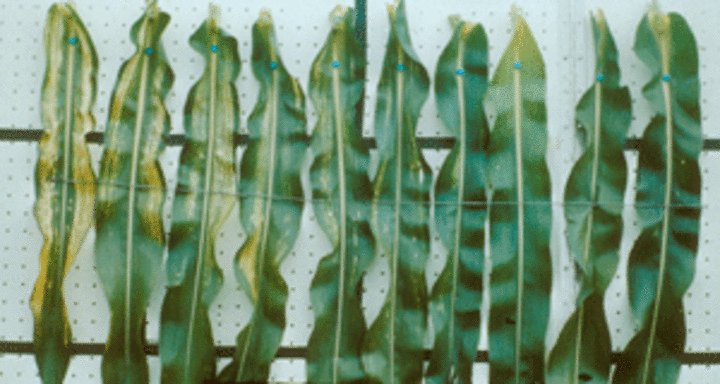April 1, 2012
Plants require seven micronutrients: boron (B), chlorine (Cl), copper (Cu), iron (Fe), manganese (Mn), molybdenum (Mo), and zinc (Zn). In Nebraska, deficiencies of iron and zinc can be common, depending on soil properties, but deficiencies of the other five micronutrients are rare.
One case each of boron deficiency has been reported on alfalfa and sugar beets, both on sandy soils. We do not know of any other confirmed micronutrient deficiencies on agronomic crops in Nebraska. With the exception of iron and zinc, the probability of profitable yield response to micronutrients is very low.

However, toxicity associated with misuse of micronutrients is a risk and has been confirmed in Nebraska.
With relatively high crop prices this year, there has been increased interest in products, including micronutrient fertilizers, that are marketed to promote crop growth. Some dealers have even gone to the extreme of mixing such products with commonly used fertilizers, often without informing producers before the invoice is sent.
Do high yield crops need exceptionally high soil availability of micronutrients? More yield means more nutrient removal. However, high yield crops have the potential to be highly efficient in nutrient uptake and utilization. High yield crops are freed from much stress, such as soil water deficits, that low yield crops encounter. High yield crops typically have healthy and extensive root systems capable of efficient nutrient uptake and healthy plants capable of efficiently converting nutrients and carbohydrates to yield. This high efficiency has been repeatedly shown for high yield corn, especially for nitrogen, but also for phosphorus and potassium. There is no evidence to the contrary for micronutrients.

For more photos of corn exhibiting deficiency symptoms, see the CropWatch Key to Nutrient Deficiencies of Corn and Sorghum.
Zinc
Zinc deficiency is most likely to occur on low organic matter, calcareous soils, but can occur on other soils. Corn is relatively sensitive to zinc deficiency, and the zinc soil test is a reliable indicator of the probability of profitable response to zinc application. When selecting between inorganic (e.g., zinc sulfate) and chelated (Zn EDTA) zinc products, consider the rates and relative costs. Inorganic zinc (not the product) is applied at two to four times the rate of chelated zinc. The chelated form should be considered for deficiency correction only. If soil test zinc is above 0.8 ppm and application is to build or maintain a high level of availability, use an inorganic form.
Iron
Iron deficiency is most common on calcareous soils. Soybean, dry bean, and sorghum are especially sensitive. Planting tolerant crops and varieties is important to management of iron deficiency. Seed dressing with iron EDDHA at 0.2 lb/ac iron has been as effective as applying 50 lb/ac iron as iron sulfate. Use this as a guideline in comparing costs.
Boron
Boron application is much promoted; however, the probability of profitable response is extremely low. Applying boron in the seed furrow can be toxic at germination and emergence. Building soil test boron levels is not feasible as it is easily leached from the soil. Irrigation typically supplies enough boron to meet crop needs.
Interpreting Micronutrient Test ResultsWhat if foliar analysis indicates a micronutrient deficiency? Such results are often used to promote micronutrient application. Treat these results with caution. First, foliar nutrient concentration can vary with rate of growth, growth stage, variety, weather conditions, and time of day. With many samples taken and several nutrients considered, there is potential for seeing occasional low levels, even with high soil fertility conditions. Second, labs and service companies differ greatly in their interpretation of foliar analysis results with some considering low to be anything below an average result, and others basing their interpretation on research relating plant response to nutrient application relative to the tissue nutrient levels. Foliar analysis for agronomic crops in Nebraska should be used to guide soil testing and additional foliar analyses for future crops but, it is not a sole justification for a nutrient application. Could you have an exceptional situation for response to micronutrients? Such claims are common, often with a high level of certainty. If you are doubtful, do your own trials, but don’t limit yourself to a mere one time, side-by-side comparison which many find to be convincing. Spatial technology makes replicated on-farm trials often easy to conduct. Even with such trials, repetition on three or more fields or years is encouraged for confidence in small yield effects. Extension Educators can help you design such a trial and interpret the results. We would also appreciate you sharing your results with us. |
Manganese
In some parts of the Corn Belt, glyphosate-tolerant soybean often respond to soil and foliar application of manganese. In trials conducted in southeast and south central Nebraska soybean did not respond to manganese application. In Kansas there was a response to both soil- and foliar-applied manganese at one of four locations.
Chloride
Crop response to chloride application has occurred in Kansas. There were no yield increases with chloride application in trials conducted with corn in southeast to south central Nebraska and with winter wheat in western Nebraska.
Copper and Molybdenum
There is no evidence of crop response to copper and molybdenum in Nebraska.
More Information
For more information see NebGuide G1830, Use and Management of Micronutrient Fertilizers in Nebraska.
Charles Wortmann
Extension Nutrient Management Specialist
